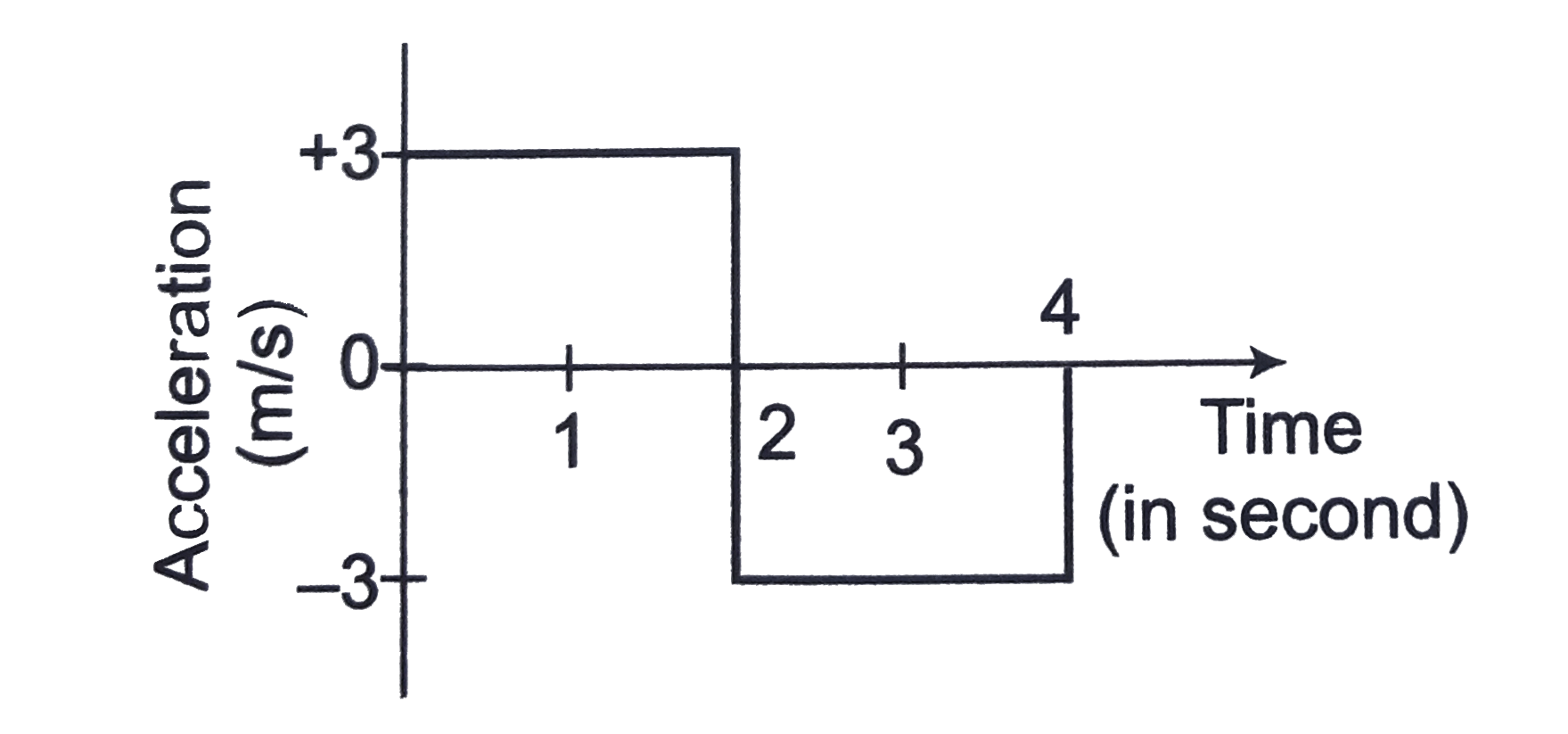A particle, initially at rest, starts moving in a straight line with an acceleration a=6t+4m/s2. The distance covered by it in 3 s is
15 m
30 m
45 m
60 m
The correct Answer is:C
To solve the problem, we need to find the distance covered by a particle that starts from rest and has an acceleration given by the equation a(t)=6t+4m/s2.
1. Understand the relationship between acceleration, velocity, and displacement:
- Acceleration a(t) is the derivative of velocity v(t) with respect to time t:
a(t)=dvdt
2. Set up the equation for acceleration:
- Given a(t)=6t+4, we can write:
dvdt=6t+4
3. Integrate to find velocity:
- To find the velocity v(t), integrate the acceleration:
v(t)=∫(6t+4)dt
- Performing the integration:
v(t)=3t2+4t+C
- Since the particle starts from rest, we have v(0)=0:
0=3(0)2+4(0)+C⟹C=0
- Therefore, the velocity function is:
v(t)=3t2+4t
4. Integrate to find displacement:
- Displacement s(t) is the integral of velocity:
s(t)=∫v(t)dt=∫(3t2+4t)dt
- Performing the integration:
s(t)=t3+2t2+D
- Since the initial displacement is zero, s(0)=0:
0=(0)3+2(0)2+D⟹D=0
- Therefore, the displacement function is:
s(t)=t3+2t2
5. Calculate the distance covered in 3 seconds:
- Substitute t=3 into the displacement equation:
s(3)=(3)3+2(3)2
- Calculate:
s(3)=27+2×9=27+18=45meters
Final Answer:
The distance covered by the particle in 3 seconds is 45 meters.
- Acceleration a(t) is the derivative of velocity v(t) with respect to time t:
a(t)=dvdt
- Given a(t)=6t+4, we can write:
dvdt=6t+4
- To find the velocity v(t), integrate the acceleration:
v(t)=∫(6t+4)dt
- Performing the integration:
v(t)=3t2+4t+C
- Since the particle starts from rest, we have v(0)=0:
0=3(0)2+4(0)+C⟹C=0
- Therefore, the velocity function is:
v(t)=3t2+4t
- Displacement s(t) is the integral of velocity:
s(t)=∫v(t)dt=∫(3t2+4t)dt
- Performing the integration:
s(t)=t3+2t2+D
- Since the initial displacement is zero, s(0)=0:
0=(0)3+2(0)2+D⟹D=0
- Therefore, the displacement function is:
s(t)=t3+2t2
- Substitute t=3 into the displacement equation:
s(3)=(3)3+2(3)2
- Calculate:
s(3)=27+2×9=27+18=45meters
The distance covered by the particle in 3 seconds is 45 meters.
Topper's Solved these Questions
- MOTION IN A STRAIGHT LINE & PLANE Book:VMC MODULES ENGLISHChapter:MOTION IN A STRAIGHT LINE & PLANE Exercise:IMPECCABLE
Explore 52 Videos
- MOTION IN A STRAIGHT LINE & PLANE Book:VMC MODULES ENGLISHChapter:MOTION IN A STRAIGHT LINE & PLANE Exercise:ENABLE
Explore 50 Videos
- MOCK TEST 9Book:VMC MODULES ENGLISHChapter:MOCK TEST 9Exercise:PHYSICS (SECTION 2)
Explore 5 Videos
- Motion in Straight Line Book:VMC MODULES ENGLISHChapter:Motion in Straight Line Exercise:IN-CHAPTER EXERCISE-J
Explore 10 Videos
Similar Questions
A particle at rest starts moving in a horizontal straight line with a uniform acceleration. The ratio of the distances covered during the fourth and third seconds is
View SolutionThe initial velocity of a body moving along a straight lines is 7m/s. It has a uniform acceleration of 4m/s2 the distance covered by the body in the 5th second of its motion is-
View SolutionA particle starts moving with acceleration 2m/s2. Distance travelled by it in 5th half second is
View SolutionA particle starts from rest at t=0 and moves in a straight line with an acceleration as shown below. The velocity of the particle at t=3 s is

View SolutionA body starts from rest with a uniform acceleration of 2 m s−1 . Find the distance covered by the body in 2 s.
View SolutionA body starting from rest is moving with a uniform acceleration of 8ms2. Then the distance travelled by it in 5th second will be
View SolutionA particle starts moving in a straight line from rest with an acceleration (inm/s2) given by : a=12√x, where x is the distance travelled by the particle (in meters ) The velocity of the particle at the instant when its acceleration is 48m/s2 is .......m/s
View SolutionA particle initially at rest, moves with an acceleration 5 m s−2 for 5 s. Find the distance travelled in (a) 4 s, (b) 5 s and (c) 5th second.
View SolutionA particle moves on a straight line, with uniorm acceleration −5m/s2. Distance travelled by it in three consecutive intervals of 1s are in ratio of 3:1:1. Then the total distance travelled in three seconds is:
View SolutionA particle starts from rest, moving in a straight line with a time varying acceleration (inm/s2):a=30−152√t, where time is in seconds . The displacement of the particle in 4 seconds is .
View Solution